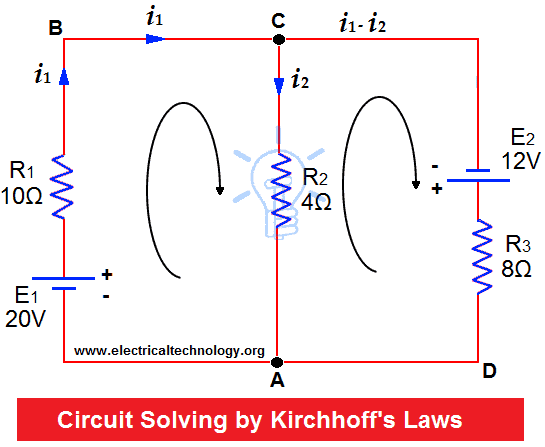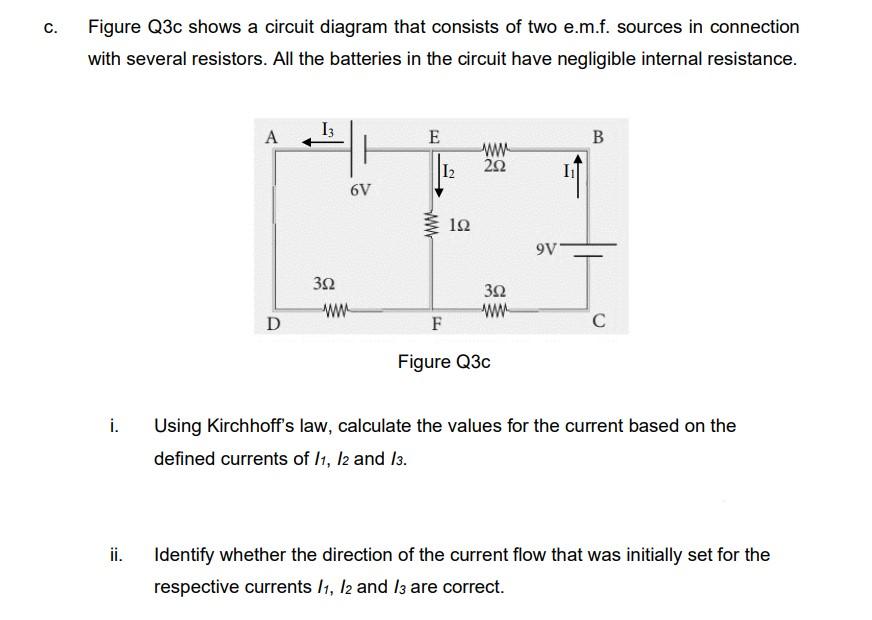Sep 12, 2022login Login how_to_reg Request Instructor Account hub Instructor Commons Search Search this book Submit Search Downloads expand_more Download Page (PDF) Download Full Book (PDF) Resources expand_more Periodic Table Physics Constants Scientific Calculator Reference expand_more Reference & Cite Tools expand_more Help expand_more Get Help Feedback
Kirchhoff’s Current & Voltage Law (KCL & KVL) | Solved Example
The circuit is completed by a return path through the stationary ionosphere. Example 9.4.1: Calculating the Large Motional Emf of an Object in Orbit. Calculate the motional emf induced along a 20.0-km conductor moving at an orbital speed of 7.80 km/s perpendicular to Earth’s 5.00 × 10 − 5T magnetic field.

Source Image: homework.study.com
Download Image
ε = V + Ir This shows that we can calculate the EMF if we know the voltage across the terminals, the current flowing and the internal resistance of the cell. Solved Examples for EMF Formula Q.1: Consider that we have a circuit with a potential difference of 3.2 V, with a current of 0.6 A. The internal resistance of the battery at 0.5 ohms.

Source Image: scribd.com
Download Image
Determine the currents I1, I2, and I3 in the figure. Assume the internal resistance of each battery is r=1.0 ohms? | Homework.Study.com If the electromotive force is not a force at all, then what is the emf and what is a source of emf? To answer these questions, consider a simple circuit of a 12-V lamp attached to a 12-V battery, as shown in Figure 10.3.The battery can be modeled as a two-terminal device that keeps one terminal at a higher electric potential than the second terminal.

Source Image: homework.study.com
Download Image
Calculate The Current I2 Flowing In Emf Source E2
If the electromotive force is not a force at all, then what is the emf and what is a source of emf? To answer these questions, consider a simple circuit of a 12-V lamp attached to a 12-V battery, as shown in Figure 10.3.The battery can be modeled as a two-terminal device that keeps one terminal at a higher electric potential than the second terminal. Jan 18, 2024Ohm’s Law Calculator Created by Mateusz Mucha and Julia Żuławińska Reviewed by Bogna Szyk and Jack Bowater Last updated: Jan 18, 2024 Cite Table of contents: Ohm’s Law Formula Voltage formula What is the equation for power? How to calculate power? Ohm’s law for anisotropic materials FAQ
In the circuit below, I=2 A. Calculate the value of the unknown emf source E. | Homework.Study.com
Explanation: Based on the values provided and assuming a simple series circuit that only includes the two voltage sources (E1 and E2), we lack enough information to calculate the current for E2 specifically. Below is a circuit with four branches. The currents I1 and I2, and the emf ε1 are unknown. The curre – YouTube

Source Image: youtube.com
Download Image
SOLUTION: Kirchoff’s Law Lab Report – Studypool Explanation: Based on the values provided and assuming a simple series circuit that only includes the two voltage sources (E1 and E2), we lack enough information to calculate the current for E2 specifically.

Source Image: studypool.com
Download Image
Kirchhoff’s Current & Voltage Law (KCL & KVL) | Solved Example Sep 12, 2022login Login how_to_reg Request Instructor Account hub Instructor Commons Search Search this book Submit Search Downloads expand_more Download Page (PDF) Download Full Book (PDF) Resources expand_more Periodic Table Physics Constants Scientific Calculator Reference expand_more Reference & Cite Tools expand_more Help expand_more Get Help Feedback

Source Image: electricaltechnology.org
Download Image
Determine the currents I1, I2, and I3 in the figure. Assume the internal resistance of each battery is r=1.0 ohms? | Homework.Study.com ε = V + Ir This shows that we can calculate the EMF if we know the voltage across the terminals, the current flowing and the internal resistance of the cell. Solved Examples for EMF Formula Q.1: Consider that we have a circuit with a potential difference of 3.2 V, with a current of 0.6 A. The internal resistance of the battery at 0.5 ohms.

Source Image: homework.study.com
Download Image
Solved Learning Goal: To practice Problem Solving Strategy | Chegg.com Mesh current i3 has to be equal to -I because it is the only current flowing through the current source. When you look at R4, however, the resistor current is the combination of (superposition of) two mesh currents, i3 and i2. You nearly got the expression for the voltage across R4 correct. It equals R4(i2 – i3).

Source Image: chegg.com
Download Image
Solved Figure Q3c shows a circuit diagram that consists of | Chegg.com If the electromotive force is not a force at all, then what is the emf and what is a source of emf? To answer these questions, consider a simple circuit of a 12-V lamp attached to a 12-V battery, as shown in Figure 10.3.The battery can be modeled as a two-terminal device that keeps one terminal at a higher electric potential than the second terminal.

Source Image: chegg.com
Download Image
Solved My answer to part B (Calculate the current I2 flowing | Chegg.com Jan 18, 2024Ohm’s Law Calculator Created by Mateusz Mucha and Julia Żuławińska Reviewed by Bogna Szyk and Jack Bowater Last updated: Jan 18, 2024 Cite Table of contents: Ohm’s Law Formula Voltage formula What is the equation for power? How to calculate power? Ohm’s law for anisotropic materials FAQ

Source Image: chegg.com
Download Image
SOLUTION: Kirchoff’s Law Lab Report – Studypool
Solved My answer to part B (Calculate the current I2 flowing | Chegg.com The circuit is completed by a return path through the stationary ionosphere. Example 9.4.1: Calculating the Large Motional Emf of an Object in Orbit. Calculate the motional emf induced along a 20.0-km conductor moving at an orbital speed of 7.80 km/s perpendicular to Earth’s 5.00 × 10 − 5T magnetic field.
Determine the currents I1, I2, and I3 in the figure. Assume the internal resistance of each battery is r=1.0 ohms? | Homework.Study.com Solved Figure Q3c shows a circuit diagram that consists of | Chegg.com Mesh current i3 has to be equal to -I because it is the only current flowing through the current source. When you look at R4, however, the resistor current is the combination of (superposition of) two mesh currents, i3 and i2. You nearly got the expression for the voltage across R4 correct. It equals R4(i2 – i3).